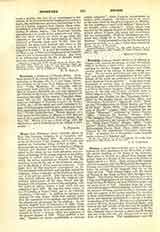

Druzes, a small Mohammedan sect in Syria, notorious for their opposition to the Maronites, a Catholic people dwelling on the slopes of the Lebanon. Their name is derived as a plural from Dorazy, the proper name of a Persian at the court of El Hakim in Egypt (about A.D. 1015). They subsequently repudiated all connection with this Mohammed Ibn Ismail el-Dorazy, and styled themselves Unitarians or Muwahhedin, on account of the emphasis they lay on the unity of God. Their history begins with the arrival of Dorazy in the Wady el-Teim after his flight from Egpyt. This Persian had had the audacity to read to a large multitude gathered in a mosque a book tending to prove that El Hakim, the mad Fatimite caliph, was an incarnation of God. Escaping from the crowd, who were enraged at this blasphemy, he fled to the valley between Hermon and the Southern Lebanon, and with the support of his master preached his doctrine to these mountaineers, already given to Batenite doctrines and therefore predisposed to accept a further incarnation of the Deity. He was soon superseded by another Persian, Hamzeh Ibn Ahmed El Hady, who became the real founder of the sect and the author of its sacred books. After the assassination of El Hakim, Hamzeh wrote a treatise to prove that El Hakim had not really died but only disappeared to test the faith of his followers. This disappearance and ultimate return of El Hakim are cardinal points of the Druze faith today. The sacred books of the Druzes, successfully hidden from the world for eight centuries, have since the middle of the last century found their way into European libraries. They are written in Arabic and affect the style of the Koran. They consist of six volumes containing 111 treatises of a controversial character or explanatory epistles to individual persons. Each book takes its name from its first treatise. Their speculations strongly reflect their Persian origin.
The Druze doctrine concerning God is characterized by its abstraction from all Divine attributes; these, it declares, would imply limitation in the Supreme Being. God, however, manifested Himself first in the Universal Mind, then in the Universal Soul, and again in the Word. These three form the first great manifestation. The second great manifestation began with the residence of the Universal Mind in Adam for a thousand years; after which Enoch took his place, and in turn was followed by the Seven Ministers, Noe, Abraham, Moses, Jesus, Mohammed, Ibn Ismail; the seventh is unknown. God appeared ten times in human form, for the last time in El Hakim. The Druzes teach a distinction between Jesus, the son of Joseph, and the Christ. Christ instructed Jesus, but finally Jesus disobeyed Christ and was crucified in consequence. Christ, who was concealed under the form of one of the Disciples of Jesus, stole the body of Jesus from the grave and gave out the report that Christ had risen, in order that the true Druzes might be concealed for awhile in the religion of Jesus. The Druzes are firm believers in the transmigration of souls, and this transmigration will never end; after the Judgment Day death it will continue, but will be painless for the saved, who will live to the age of 120 years, and whose souls will forthwith be reborn and reenter a life of peace and pleasure. The Druzes are unshakably convinced that the whole of China is peopled with adherents of their religion. The Judgment Day, or rather the golden age for the Druzes, will be at hand when the Christians wax greater than the Mohammedans, some nine hundred years after the disappearance of El Hakim. Then the Christians, aided by the King of Abyssinia, a sort of Antichrist called “The Antagonist”, will march against the Caaba in Mecca. The hosts of Christ and Mohammed will meet, but only to be both overcome by 2,500,000 Chinese Druzes. Moslems and Christians will both be reduced to everlasting slavery, and the Unitarians will reign forever. The Druze religion contains seven moral precepts: veracity, love of the brethren, forsaking of idolatry, repudiation of devils, acknowledgment of God‘s unity at all times, secrecy in religion, and resignation to the will of God.
The Druzes are divided into two main classes: the Ukkal, or initiated, and the Juhhal, or uninitiated; amongst the former, the Iwayid profess the strictest Druze principles. They meet on Thursday evenings for worship, which consists almost exclusively in reading their sacred books. They often comply with the outward observances of Islam and even make pretense of being Mohammedans, but they are officially designated as unbelievers. They live mostly in the Lebanon, but are also found in the Hauran and in the districts near Damascus; their total number is estimated at 100,000 or a few thousand more. Encouraged by Turkish authorities, the Druzes in 1860 attacked the Catholic Maronites, and are said to have massacred some ten thousand of them. The massacres were stayed mainly through English and French intervention.
J. P. ARENDZEN

